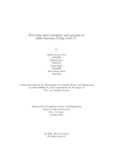| dc.contributor.advisor | Chakrabarty, Dr. Amitabha | |
| dc.contributor.author | Das, Shishir Kumar | |
| dc.contributor.author | Nisa, Khairun | |
| dc.contributor.author | Kabir, Razit | |
| dc.contributor.author | Tonni, Israt Jahan | |
| dc.date.accessioned | 2024-05-05T05:11:49Z | |
| dc.date.available | 2024-05-05T05:11:49Z | |
| dc.date.copyright | 2023 | |
| dc.date.issued | 2023-01 | |
| dc.identifier.other | ID: 22241123 | |
| dc.identifier.other | ID: 19101376 | |
| dc.identifier.other | ID: 22241180 | |
| dc.identifier.other | ID: 22241189 | |
| dc.identifier.uri | http://hdl.handle.net/10361/22718 | |
| dc.description | This thesis is submitted in partial fulfillment of the requirements for the degree of Bachelor of Science in Computer Science, 2023. | en_US |
| dc.description | Cataloged from PDF version of thesis. | |
| dc.description | Includes bibliographical references (pages 50-52). | |
| dc.description.abstract | COVID-19 pandemic has created a lot of challenges for student learning and educa tion across the globe. As a result of the global increase of the state of COVID-19,
numerous educational institutions in the whole world were closed in 2020 and moved
to online or remote learning, which had a variety of effects on student learning. As
a result teachers and students spent more time online than ever before, with both
groups studying, learning, and getting acquainted themselves with information, as sets, tools, and structures in order to adapt to online or virtual learning. On the
basis of COVID-19, studying different opinions about online learning as the Big
Data mining and analysis of tweets from the people of various countries around the
world provides the opportunity to identify, quantify, and investigate the needs, chal lenges, and interests related to online learning in various countries around the world.
Analyzing the sentiment of people they want to express through their tweets gives
us a clear view of their opinion about online learning. Moreover, a huge number
of tweets are sarcastic and it will not be possible to crack the sentiment of a maxi mum number of people without identifying the sarcastic tweets. Different types of
methods were used for these analyses. Twitter is the most popular and used social
media platform around the globe for many years. So, tweet data in the form of
search interests related to online learning was mined for the creation of this dataset
using Rapid Miner and Twitter API. As the dataset is created based on only the
tweets during the covid19 the data is much less to get a more perfect result.We have
analyzed the sentiment using the stemmed feature and applied a few models among
which we get the best result from the logistic regression model which is 70.63%
and for the sarcasm detection, we used 3 features and overall get the best accuracy
76.19% from tf-idf, 76.94% from the stemmed feature. The more information the
datasets can have the more identical the changes will be. So, work on the datasets
should also be continued. | en_US |
| dc.description.statementofresponsibility | Shishir Kumar Das | |
| dc.description.statementofresponsibility | Khairun Nisa | |
| dc.description.statementofresponsibility | Razit Kabir | |
| dc.description.statementofresponsibility | Israt Jahan Tonni | |
| dc.format.extent | 52 pages | |
| dc.language.iso | en | en_US |
| dc.publisher | Brac University | en_US |
| dc.rights | Brac University theses are protected by copyright. They may be viewed from this source for any purpose, but reproduction or distribution in any format is prohibited without written permission. | |
| dc.subject | Data mining | en_US |
| dc.subject | Machine learning | en_US |
| dc.subject | Tweet | en_US |
| dc.subject | Sarcasm | en_US |
| dc.subject | Prediction | en_US |
| dc.subject | Decision tree | en_US |
| dc.subject | Linear regression analysis | en_US |
| dc.subject | Online learning | en_US |
| dc.subject.lcsh | Computational linguistics. | |
| dc.subject.lcsh | Natural language processing (Computer science) | |
| dc.title | Detecting tweet sentiment and sarcasm on online learning during covid-19 | en_US |
| dc.type | Thesis | en_US |
| dc.contributor.department | Department of Computer Science and Engineering, Brac University | |
| dc.description.degree | B.Sc. in Computer Science | |

